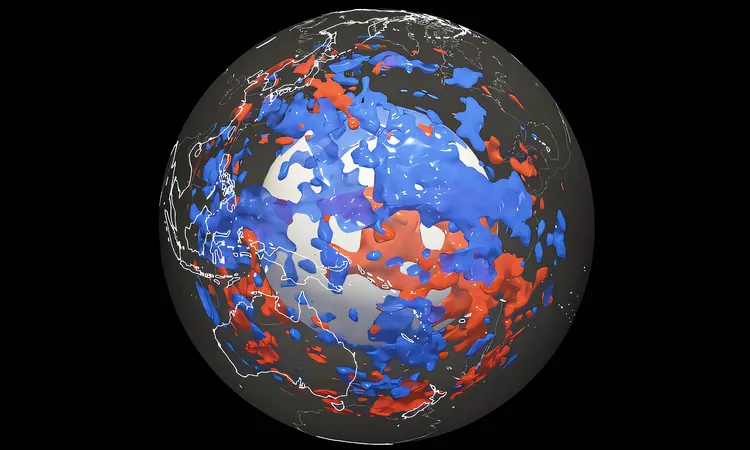
Hidden Secrets of the Pacific: 'Sunken Worlds' Unearthed Beneath the Earth’s Mantle
2025-01-11
Author: Siti
Hidden Secrets of the Pacific: 'Sunken Worlds' Unearthed Beneath the Earth’s Mantle
Scientists have long envisioned Earth's interior as a neatly layered structure, akin to a delicious layered cake. However, recent groundbreaking research is revealing a far more intricate and surprising reality hidden beneath our feet.
Seismologists, who traditionally utilized specific earthquake wave patterns to probe the depths of Earth, are now employing an innovative technique called full-waveform inversion. This state-of-the-art method is enabling researchers to construct a more detailed three-dimensional model of Earth's mantle, hinting at the existence of hidden geological material in areas previously thought to be void of any substantial structure.
The Mantle: An Overview
The mantle is the expansive layer of rock sandwiched between Earth's crust and core, plunging approximately 1,800 miles (2,900 kilometers) deep and constituting about 84% of the planet's volume. Composed mainly of silicate minerals with a rich iron and magnesium content, the mantle is primarily solid but exhibits a thick, slow-flowing behavior over extended time periods. This slow flow fundamentally drives the movement of tectonic plates, resulting in earthquakes, volcanic activity, and the gradual shifting of continents.
The convection currents generated by heat from the Earth's core facilitate this flow. Hot material rises, cools near the surface, and sinks back down, creating a dynamic cycle that shapes the surface of the planet.
Shocking Discoveries Beneath the Surface
By applying the full-waveform inversion technique, researchers can now capture a comprehensive array of seismic waves produced during earthquakes, leading to stunning discoveries about the mantle. Astonishingly, they found pockets that seem to be remnants of tectonic plates in regions lacking a history of subduction, uncovering hidden anomalies that challenge conventional geological wisdom.
One particularly striking revelation emerged from the western Pacific Ocean, where scientists were surprised to find ancient plate fragments in a region devoid of historical plate collision data. "Such zones in the Earth’s mantle appear to be much more widespread than previously thought," stated doctoral student Thomas Schouten from the Geological Institute of ETH Zurich, who's working alongside experts from the California Institute of Technology.
Mysteries of Seismic Signals
When earthquakes occur, they generate waves that radiate through the Earth, revealing critical information about its internal structures. Like a form of medical imaging, researchers analyze the time these waves take to reach different seismic stations across the globe. Their velocity provides clues about rock density and composition, leading to new insights derived from the data.
In this latest research effort, the team identified unforeseen shapes and densities within Earth's lower mantle, uncovering the possibility that some geological features are neither mere plate fragments nor entirely what scientists had previously imagined.
The Significance of These Findings
Understanding the mantle's composition is crucial, as it influences geological phenomena such as volcanic activity, seismic events, and continental drift. The discovery of these new anomalies could significantly reshape existing theories about plate tectonics and indicate the presence of diverse compositions within the mantle.
Some scientists speculate that the newly found structures might be silica-rich remnants from the early mantle or accumulations of iron-rich materials that have drifted over billions of years. The complexity of these findings underscores the importance of ongoing research into Earth's internal processes.
Future Research Directions
As scientists delve deeper into this fascinating subject, they emphasize the need for further refinement of the full-waveform inversion method. They are also exploring other datasets, including electromagnetic signals and mineral physics experiments, to understand better the origin of these enigmatic structures.
If such hidden zones exist more widely in Earth's depths, it may necessitate a reevaluation of theories concerning heat transfer and convection patterns within the mantel. These findings could lead to new narratives about the dynamics of plate movement and the evolution of our planet.
In the coming years, advancements in computational power will likely facilitate the analysis of even larger datasets, revealing clearer images of Earth's lower mantle. By integrating seismic data, chemical analyses, and advanced computing techniques, scientists will continue to unravel the intricacies of our planet's hidden realms, proving that our understanding of Earth is always evolving.
Stay tuned as this thrilling chapter of Earth's story unfolds—who knows what secrets the depths of the Pacific might reveal next!
 Brasil (PT)
Brasil (PT)
 Canada (EN)
Canada (EN)
 Chile (ES)
Chile (ES)
 Česko (CS)
Česko (CS)
 대한민국 (KO)
대한민국 (KO)
 España (ES)
España (ES)
 France (FR)
France (FR)
 Hong Kong (EN)
Hong Kong (EN)
 Italia (IT)
Italia (IT)
 日本 (JA)
日本 (JA)
 Magyarország (HU)
Magyarország (HU)
 Norge (NO)
Norge (NO)
 Polska (PL)
Polska (PL)
 Schweiz (DE)
Schweiz (DE)
 Singapore (EN)
Singapore (EN)
 Sverige (SV)
Sverige (SV)
 Suomi (FI)
Suomi (FI)
 Türkiye (TR)
Türkiye (TR)
 الإمارات العربية المتحدة (AR)
الإمارات العربية المتحدة (AR)